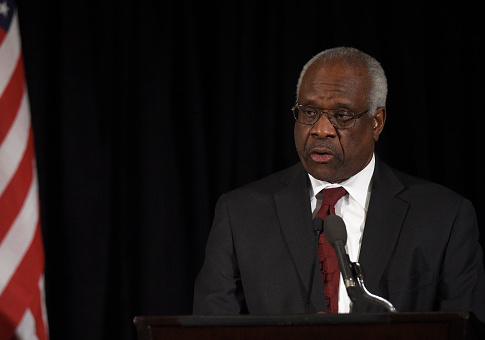The Smithsonian's National Museum of African American History and Culture added a display featuring Supreme Court Justice Clarence Thomas shortly before the museum's one-year anniversary on Sunday.
The display will honor both Thomas and Thurgood Marshall, the only other black justice to serve on the nation's highest court, the Washington Times reported Monday.
The museum, which opened last year in September, came under fire for barely including Thomas, despite his distinguished life and legal career. Thomas, who became chairman of the Equal Employment Opportunity Commission in 1982 and was later nominated to the Supreme Court by President George H.W. Bush, was not showcased, while Anita Hill, the woman who accused him of sexual harassment, was portrayed as a woman of courage.
Some conservative observers saw the omission of Thomas, a noted conservative jurist who tries to uphold the Constitution's original meaning, as a form of ideological bias among Smithsonian officials. Republican Sen. Ted Cruz (Texas) wrote a letter to the museum's curators last year saying he was "deeply disturbed" by the omission. Cruz called Thomas an "intellectual leader" and described him as an "African American who survived segregation, defeated discrimination, and ascended all the way to the Supreme Court."
Congressional Republicans in December introduced resolutions asking the museum to recognize the "historical importance" of Thomas.
The museum's decision to feature Thomas on Sunday came just in time to celebrate the museum's one-year anniversary.
Ronald D. Rotunda, distinguished professor of jurisprudence at the Dale E. Flower School of Law at Chapman University, said that Thomas was an "influential justice" who came from "humble beginnings."
"His father left him, his grandparents raised him," Rotunda told the Times. "The 1968 assassination of Martin Luther King Jr. turned him to the law. He left a successful corporate law practice and turned to public service. That path led him to the Supreme Court."
Rotunda said it is "surprising that it has taken so long" for Thomas to be represented in the museum given his influence as a "seminal figure on the U.S. Supreme Court."
The National Museum of African American History and Culture is the Smithsonian's 19th and most popular institution, attracting nearly 3 million people during its first year. While the museum initially did not mention Thomas, it has recognized the Black Panthers, the Black Lives Matter movement, and hip-hop culture. Museum curators said last month that gear worn by Colin Kaepernick, the former San Francisco 49ers quarterback who made headlines by kneeling for the national anthem, would be displayed.
Linda St. Thomas, chief spokeswoman for the Smithsonian Institution, said the museum is "evolving and other things will change over time."
Former President Barack Obama, the nation's first black president, rang a church bell signaling the opening of the museum on Sept. 24, 2016.
